
23 Mar TOP ESIM STATISTICS 2025
Over the past five years, the world of connectivity has undergone a quiet revolution—and at the center of it is the eSIM. Short for Embedded Subscriber Identity Module, eSIM technology is rapidly replacing traditional plastic SIM cards, offering consumers and businesses more flexibility, easier activation, and seamless switching between carriers. As smartphones, smartwatches, connected cars, and IoT devices evolve, eSIM adoption is accelerating across every corner of the globe. From telecom giants to automotive innovators, industries are integrating eSIM into their long-term strategies—not just as a feature, but as a foundational infrastructure. Here at Amra and Elma we explore the top 15 eSIM statistics for 2025, unpacking their implications and what they reveal about the future of mobile connectivity. Whether you’re a tech enthusiast, marketer, investor, or industry professional, these numbers paint a clear picture: eSIM isn’t just the future—it’s already here.
ESIM STATISTICS 2025 (Editor’s Choice)
eSIM (Embedded Subscriber Identity Module) technology has experienced significant growth over the past five years and is poised for further expansion in the coming years. Here are 15 key statistics highlighting its evolution and future prospects:
-
Market Size Growth:
- The global eSIM market was valued at approximately $7.3 billion in 2021 and reached $8.34 billion in 2022.
- The global eSIM market was valued at approximately $7.3 billion in 2021 and reached $8.34 billion in 2022.
-
Projected Market Value:
- Forecasts suggest the eSIM market will grow to $10.8 billion by 2025, with expectations of reaching $17.5 billion by 2030.
- Forecasts suggest the eSIM market will grow to $10.8 billion by 2025, with expectations of reaching $17.5 billion by 2030.
-
Compound Annual Growth Rate (CAGR):
- The eSIM market is anticipated to grow at a CAGR between 7% and 10.2% from 2022 to 2030.
- The eSIM market is anticipated to grow at a CAGR between 7% and 10.2% from 2022 to 2030.
-
Device Shipments:
- eSIM-capable smartphone shipments increased by 11% year-over-year in 2022, reaching 424 million units.
- eSIM-capable smartphone shipments increased by 11% year-over-year in 2022, reaching 424 million units.
-
eSIM-Compatible Devices:
- As of April 2024, there are 169 smartphones supporting eSIM technology, marking a 106% increase from March 2023.
- As of April 2024, there are 169 smartphones supporting eSIM technology, marking a 106% increase from March 2023.
-
Smartphone Sales:
- By 2025, 60% of all smartphone unit sales are estimated to be eSIM-compatible.
-
Global Adoption:
- Between 2 and 3 billion smartphone connections worldwide are projected to use eSIM by 2025, depending on adoption scenarios.
-
China’s Market:
- China is expected to become the largest eSIM market, with an estimated half a billion eSIM smartphone connections by 2025.
- China is expected to become the largest eSIM market, with an estimated half a billion eSIM smartphone connections by 2025.
-
Automotive Industry:
- By 2025, the automotive industry is expected to account for 25% of the eSIM market, as car manufacturers adopt eSIM for connected vehicles.
-
IoT Devices:
- By 2025, over 30% of IoT devices are projected to be connected via eSIM, simplifying device management and providing greater flexibility.
-
Remote SIM Provisioning:
- By 2024, 40% of mobile operators are expected to adopt advanced Remote SIM Provisioning (RSP) systems to offer more seamless eSIM management to their customers.
-
Operator Adoption:
- As of June 2023, over 400 operators provided commercial eSIM services for smartphones, indicating rapid deployment and support.
-
Consumer Awareness:
- On average, 36% of consumers across seven major markets are aware of eSIM, an increase from 20% in 2020.
-
eSIM in Wearables:
- By 2025, 99% of smartwatches are expected to support eSIM, followed by laptops at 73% and smartphones at 47%.
-
Global Device Demand:
-
The demand for eSIM-enabled devices is projected to surge, reaching 16 billion devices by 2030—a 1354.5% increase from 2024.
-
These statistics underscore the rapid adoption and integration of eSIM technology across various sectors, highlighting its pivotal role in the future of connectivity.
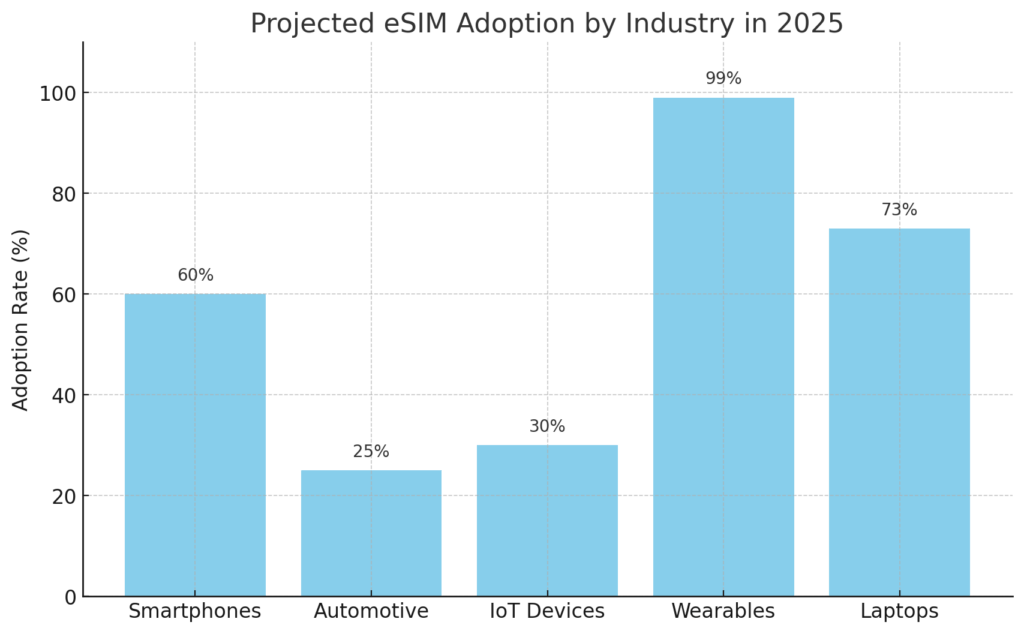
ESIM STATISTICS 2025 and Future Implications
ESIM STATISTICS 2025 #1. Market Size Growth
The global eSIM market grew from approximately $7.3 billion in 2021 to $8.34 billion in 2022, showcasing steady expansion. This growth reflects the rising consumer and enterprise demand for seamless mobile connectivity and reduced reliance on physical SIM cards. As telecom providers embrace digital-first approaches, eSIMs provide flexibility, especially for international travelers and multi-device users. The growth also indicates increasing integration of eSIM technology in wearables, tablets, and laptops. Looking ahead, this trend suggests that eSIMs will become a default feature rather than a premium offering, accelerating the decline of physical SIM infrastructure. This may lead to streamlined logistics and lower operational costs for carriers.
ESIM STATISTICS 2025 #2. Projected Market Value
By 2025, the global eSIM market is projected to reach $10.8 billion and grow further to $17.5 billion by 2030. This exponential growth suggests that the technology is not only here to stay but is poised to dominate mobile connectivity. Industries like automotive, consumer electronics, and IoT are driving demand as they adopt eSIMs to streamline connectivity. As more countries and telecom operators support the infrastructure, users will enjoy easier plan switching and better device compatibility. Companies that invest early in eSIM tech could benefit from reduced churn and improved customer experience. This anticipated market size signals an era where embedded connectivity becomes the new standard across all connected devices.
ESIM STATISTICS 2025 #3. Compound Annual Growth Rate (CAGR)
The eSIM market is expected to grow at a CAGR of 7% to 10.2% from 2022 to 2030, reflecting strong investor and industry confidence. This consistent rate of growth signifies both broad adoption across industries and increasing consumer demand for connected experiences. Growth is particularly high in sectors like automotive and industrial IoT, where remote provisioning is essential. A steady CAGR also suggests maturity in the market, enabling innovation around user interfaces, integration, and cross-device connectivity. For investors and tech companies, this presents a fertile ground for new applications and services. We can expect further diversification of eSIM use cases, especially in smart homes and connected healthcare.
ESIM STATISTICS 2025 #4. Device Shipments
In 2022, eSIM-compatible smartphone shipments rose by 11% year-over-year to reach 424 million units. This increase shows that device manufacturers are prioritizing eSIM support in new models, especially flagships. Apple and Samsung, for example, now regularly include eSIM compatibility, with some models relying entirely on eSIM in specific markets. As eSIM becomes more mainstream, hardware and software ecosystems will evolve to fully support eSIM-only user flows. This surge also points to improved carrier support, making it easier for users to activate devices digitally. Going forward, consumers may expect faster setup processes and fewer retail visits when switching networks.
ESIM STATISTICS 2025 #5. eSIM-Compatible Devices
As of April 2024, there are 169 smartphones that support eSIM, up 106% from March 2023. According to eSIM Worldwide, this rapid growth in device support demonstrates that manufacturers are responding to both market trends and regulatory encouragement toward digital transformation. The increasing availability of eSIM-enabled devices across price points will democratize access to advanced connectivity features. It also supports sustainability goals by reducing the need for plastic SIM cards and packaging. In the near future, expect even budget and mid-range phones to ship with eSIM functionality by default. This will shift consumer expectations and pressure smaller carriers to improve their eSIM offerings.
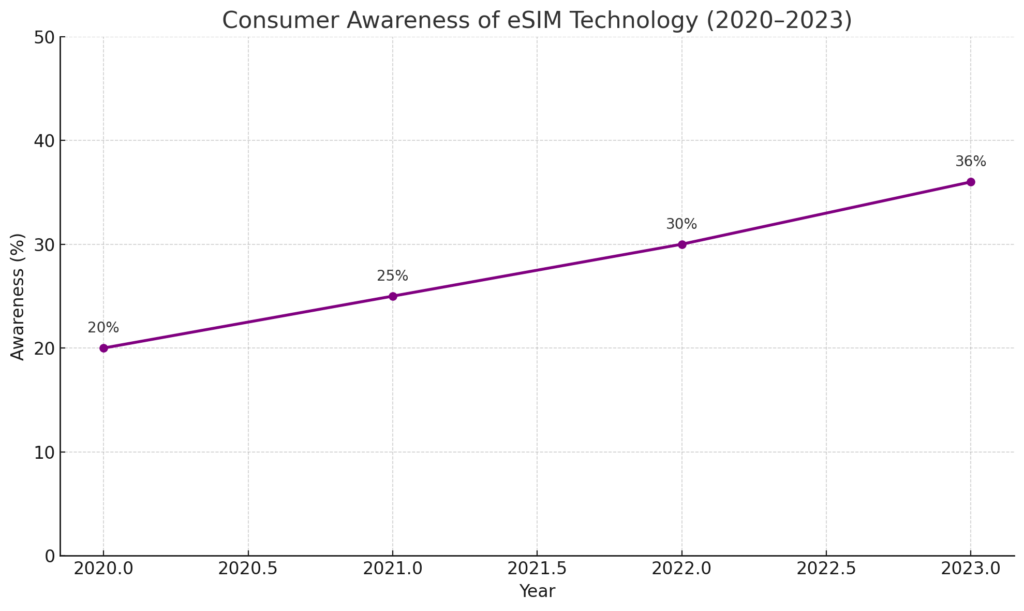
ESIM STATISTICS 2025 #6. Smartphone Sales by 2025
By 2025, an estimated 60% of all smartphone unit sales will be eSIM-compatible. This figure marks a tipping point, as eSIM technology transitions from niche to mainstream. With major OEMs like Apple, Samsung, and Google adopting eSIM, it’s becoming a standard across product lines. The rise in eSIM-ready smartphones will help drive better carrier competition, since switching providers becomes easier without needing a physical SIM. For consumers, this means more flexibility, easier travel, and faster activation experiences. Telecom companies will need to rethink customer acquisition strategies to adapt to this shift.
ESIM STATISTICS 2025 #7. Global Adoption Forecast
By 2025, between 2 and 3 billion smartphone connections are expected to be powered by eSIM. This level of penetration shows that eSIM is quickly becoming a dominant technology on a global scale. Emerging markets are expected to benefit from reduced supply chain and logistics barriers associated with physical SIMs. Carriers will need to scale up digital onboarding and security protocols to handle this volume of connections. With so many users connected via eSIM, companies offering digital identity and mobile security services will see increased demand. This could also enhance global interoperability for travelers and international professionals.
ESIM STATISTICS 2025 #8. China’s eSIM Growth
China is projected to become the largest eSIM market, with around 500 million eSIM smartphone connections by 2025. Government support and a strong domestic tech ecosystem are fueling this growth. Chinese OEMs like Huawei and Xiaomi are heavily investing in eSIM-enabled devices to gain a competitive edge. With China setting standards in mobile connectivity, global operators may look to Chinese models for implementing large-scale eSIM networks. This massive user base will help bring down the cost of eSIM provisioning globally. Additionally, it may speed up the creation of new services tailored to the Chinese market, like multi-carrier support and instant roaming.
ESIM STATISTICS 2025 #9. Automotive Industry Share
By 2025, the automotive industry is expected to account for 25% of the total eSIM market. As cars become more connected, eSIM enables real-time navigation, diagnostics, over-the-air updates, and entertainment. Manufacturers like Tesla, BMW, and Ford are already integrating eSIMs into their vehicles for these purposes. This trend highlights the growing importance of connectivity in the consumer vehicle experience. It also opens the door for subscription-based car features and dynamic insurance models based on real-time data. Future vehicles may even support multiple eSIM profiles, enabling personal and fleet uses simultaneously.
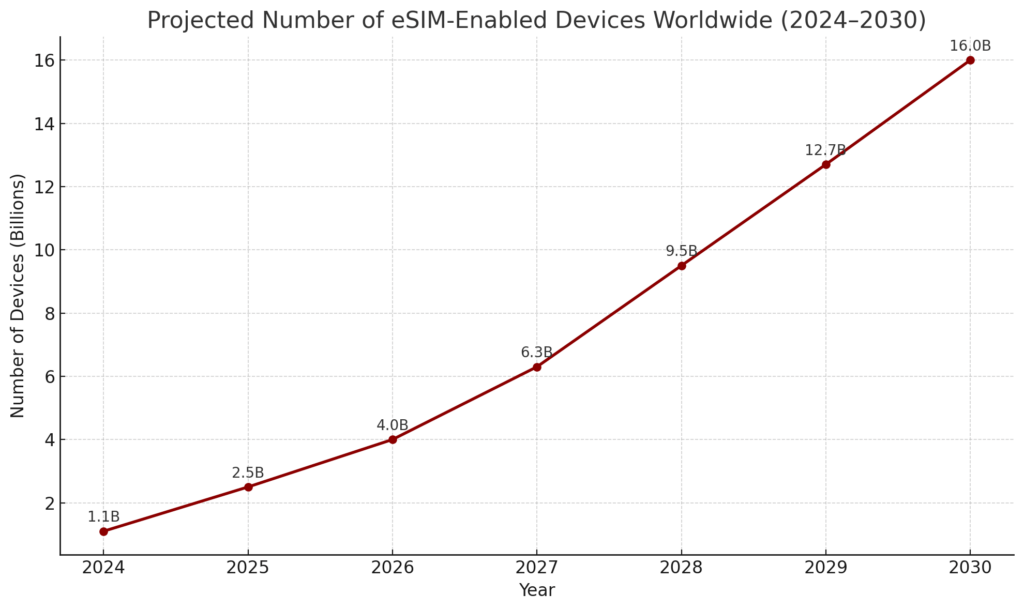
ESIM STATISTICS 2025 #10. IoT Devices & eSIM
By 2025, over 30% of IoT devices are expected to use eSIMs for connectivity. This simplifies deployment in hard-to-reach or remote environments by enabling remote SIM provisioning. Smart meters, connected appliances, agricultural sensors, and industrial monitors will benefit from eSIM technology. It removes the need for manual intervention during setup and maintenance, reducing operating costs. With this trend, we’ll likely see a boost in automation and smarter decision-making across industries. The challenge for businesses will be managing large-scale eSIM fleets, which will spur demand for better management platforms.
ESIM STATISTICS 2025 #11. Remote SIM Provisioning Adoption
By 2024, 40% of mobile operators are expected to implement advanced Remote SIM Provisioning (RSP) systems. These platforms allow users to activate and switch plans over the air, greatly enhancing customer convenience. RSP is critical to unlocking the full potential of eSIM, especially in IoT and consumer markets. Its adoption marks a shift in how carriers interact with customers, moving from physical infrastructure to cloud-based services. This also reduces churn, since customers can switch plans without leaving their device ecosystem. As RSP matures, expect integration with other services like digital ID verification and instant payment systems.
For iPhone users you can Download from the App Store
For Android users you can Download from Google Play Store
ESIM STATISTICS 2025 #12. Operator Adoption
As of mid-2023, more than 400 operators globally support eSIM for smartphones. This widespread support shows the telecom industry’s readiness to shift toward digital-only operations. The growth in operator participation ensures that more users—regardless of geography—can benefit from eSIM functionality. It also fosters global competition, allowing smaller carriers to offer plans that can compete with larger incumbents. As more operators launch eSIM-exclusive plans or digital onboarding, we can expect a rethinking of pricing strategies. The increased support will further drive smartphone brands to make eSIM-only devices.
ESIM STATISTICS 2025 #13. Consumer Awareness
Consumer awareness of eSIM rose from 20% in 2020 to 36% in 2023 across major markets. This indicates that educational campaigns and device manufacturer marketing are working. As more consumers become familiar with the benefits—such as flexibility, convenience, and faster activation—demand will accelerate. However, awareness is still less than 50%, signaling room for improvement. Increased education efforts by both OEMs and carriers will be crucial in maximizing adoption. Once awareness crosses the majority threshold, we could see the decline of physical SIM cards much faster than projected.
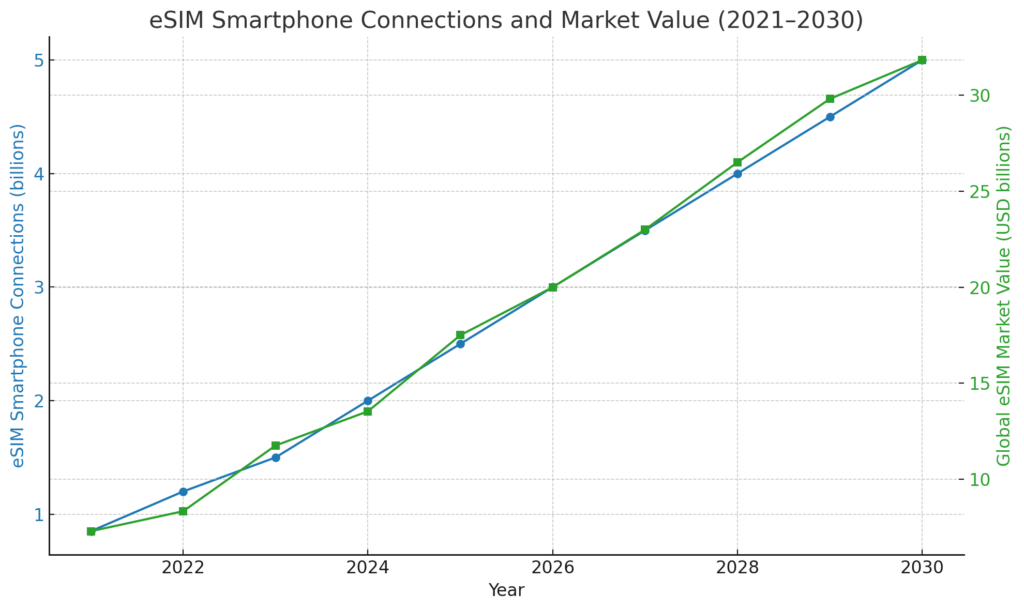
ESIM STATISTICS 2025 #14. eSIM in Wearables
By 2025, an estimated 99% of smartwatches, 73% of laptops, and 47% of smartphones will support eSIM. This surge across device categories shows that eSIM is becoming foundational to modern connectivity. Wearables, in particular, benefit from the reduced size and power consumption that eSIMs offer. It also allows users to maintain connectivity without relying on their smartphone’s connection. As more devices become eSIM-capable, users will likely maintain multiple active lines on various devices under one profile. This points to a future where every device you wear or carry is independently connected yet centrally managed.
ESIM STATISTICS 2025 #15. Global Device Demand to 2030
By 2030, the number of eSIM-enabled devices is projected to reach 16 billion, up 1,354.5% from 2024 levels. This enormous increase underscores eSIM’s role as the connectivity standard for the next generation of tech. From smart home devices to industrial machines, eSIM enables easier and more scalable deployment. With this growth, expect breakthroughs in device interoperability and multi-network support. Enterprises will need robust management tools to handle millions of simultaneous eSIM connections. Ultimately, this explosion in device demand will create new business models in cloud connectivity, digital identity, and real-time analytics.
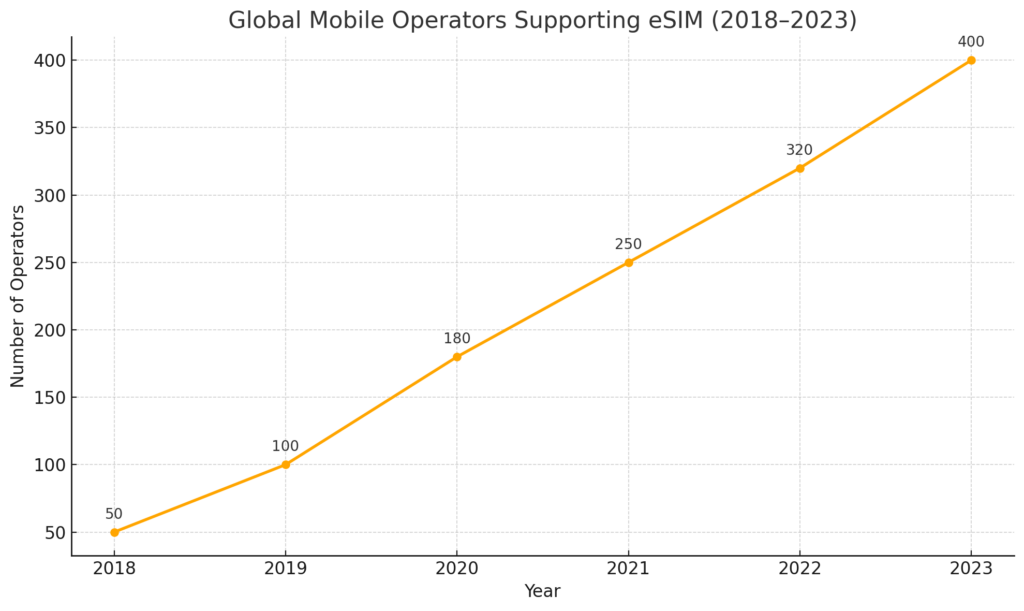
Conclusion: The Era of Embedded Connectivity Has Arrived
As these top 15 eSIM statistics for 2025 make clear, we’re witnessing a monumental shift in how the world connects. From billions of smartphones and IoT devices to smart cars and wearables, eSIM is redefining convenience, efficiency, and scale. It’s not just about replacing the SIM card—it’s about reimagining the infrastructure behind global communication. With massive adoption across industries, support from hundreds of operators, and a growing base of informed consumers, eSIM is no longer a future technology—it’s today’s competitive edge. Brands that embrace eSIM now will be better positioned to deliver seamless experiences, reduce costs, and stay ahead in an increasingly digital-first world. As we move toward 2030, one thing is certain: embedded connectivity isn’t optional—it’s essential.
Sources:
-
Market Size Growth
https://www.mobiliseglobal.com/50-esim-statistics-in-2023/ -
Projected Market Value
https://www.mobiliseglobal.com/50-esim-statistics-in-2023/ -
Compound Annual Growth Rate (CAGR)
https://www.mobiliseglobal.com/50-esim-statistics-in-2023/ -
Device Shipments
https://www.mobiliseglobal.com/50-esim-statistics-in-2023/ -
eSIM-Compatible Devices
https://www.mobiliseglobal.com/50-esim-statistics-in-2023/ -
Smartphone Sales by 2025
https://www.mobiliseglobal.com/50-esim-statistics-in-2023/ -
Global Adoption Forecast (2-3 Billion Connections)
https://www.esim.net/helpdesk/esim-trends-insights-2025-infographic/ -
China’s eSIM Growth
https://www.esim.net/helpdesk/esim-trends-insights-2025-infographic/ -
Automotive Industry Share
https://scoop.market.us/esim-statistics/ -
IoT Devices & eSIM
https://scoop.market.us/esim-statistics/ -
Remote SIM Provisioning Adoption
https://scoop.market.us/esim-statistics/ -
Operator Adoption
https://www.linkedin.com/pulse/useful-esim-statistics-know-2024-keepgo-c4nfe/ -
Consumer Awareness
https://www.linkedin.com/pulse/useful-esim-statistics-know-2024-keepgo-c4nfe/ -
eSIM in Wearables (Smartwatch, Laptops, etc.)
https://www.mobiliseglobal.com/50-esim-statistics-in-2023/ -
Global Device Demand to 2030
https://www.mobiliseglobal.com/50-esim-statistics-in-2023/

